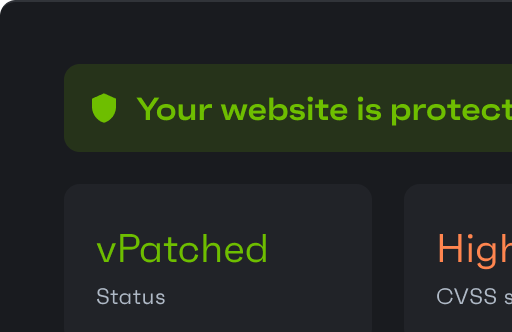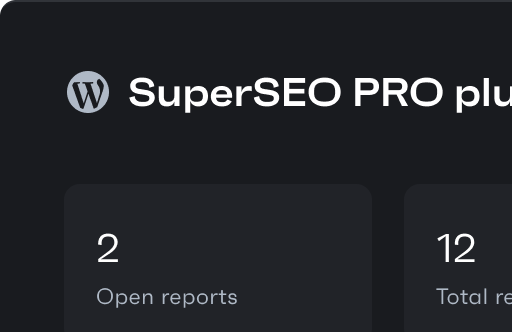The fastest vulnerability protection for your websites
first to secure 600 plugins' users
we manage security for 600 plugins
 WP Bakery
WP Bakery MainWP
MainWP Slider Revolution
Slider Revolution Visual Composer
Visual Composer WP Rocket
WP Rocket WP Bakery
WP Bakery MainWP
MainWP Slider Revolution
Slider Revolution Visual Composer
Visual Composer WP Rocket
WP Rocket
 WP Bakery
WP Bakery MainWP
MainWP Slider Revolution
Slider Revolution Visual Composer
Visual Composer WP Rocket
WP Rocket
 WP Bakery
WP Bakery MainWP
MainWP Slider Revolution
Slider Revolution Visual Composer
Visual Composer WP Rocket
WP Rocket
 WP Bakery
WP Bakery MainWP
MainWP Slider Revolution
Slider Revolution Visual Composer
Visual Composer WP Rocket
WP Rocket
 WP Bakery
WP Bakery MainWP
MainWP Slider Revolution
Slider Revolution Visual Composer
Visual Composer WP Rocket
WP Rocket
Developer
RecommendedWebsites
Monthly, billed annually
$89
Monthly
$99
Best for professionals and agencies who build and maintain websites that need uncompromised security.
Start 30-day trialIncludes
- 3 seats (add more for $24/seat/mo)
- Add +5 sites for $12.50/mo
- Protection up to 48h in advance
- Rapid mitigation without changing code
- API integrations NEW
- Remote software management
- Remote security hardening
Enterprise
Custom billing
Websites
Quote based
Starting from monthly
$1,499
Best for web hosts and businesses who require advanced security, compliance and manage security at scale.
Request quoteIncludes everything in Developer, and
- Extended API endpoints NEW
- Service Level Agreement (SLA)
- Data Processing Agreement (DPA)
- Custom billing options
- Enterprise-level support
30-day money back guarantee
SSL 256-bit secure payment
VAT is calculated at checkout
Why Patchstack?
Fastest vulnerability mitigation & protection
Protect vulnerable plugins without changing code and breaking the fidelity of websites.
Benefits
Developer
Enterprise
Protection up to 48h in advance
Text here
Text here
Rapid mitigation without changing code
Text here
Text here
Community IP blocklist module
Text here
Text here
Advanced hardening module
Text here
Text here
Generic OWASP module
Text here
Text here
Remote hardening settings
Text here
Text here
Custom protection rules
Text here
Text here
Industry leading vulnerability intelligence & management
The #1 vulnerability discloser globally with exclusive intel for 560+ WordPress plugins.
Benefits
Developer
Enterprise
Automatic vulnerability detection
Text here
Text here
Vulnerability intel up to 48h in advance
Text here
Text here
API integration into existing workflows
NEWText here
Text here
Remote software management
Text here
Text here
Auto-update vulnerable software
Text here
Text here
Custom alerts
Text here
Text here
Compliance
Comply with emerging open-source software security compliance standards.
Benefits
Developer
Enterprise
PCI-DSS 4.0 compliance for eCommerce
Text here
Text here
SOC 2 compliance
Text here
Text here
Service Level Agreement (SLA)
Text here
Text here
Data Processing Agreement (DPA)
Text here
Text here
Reporting
Share website security and protection data with clients.
Benefits
Developer
Enterprise
Real-time snapshots
Text here
Text here
Periodical activity reports
Text here
Text here
Report scheduling
Text here
Text here
Report white-labeling
Text here
Text here
Data retention
12 months
24 months
Patchstack works with all popular webhosts










Webhost? Generate revenue by seamlessly integrating Patchstack into your hosting panel.
Contact sales
Software developer? Start a free Vulnerability Disclosure Program and comply with CRA.
Set up free VDP
What the FAQ?
Yes, Patchstack also prevents malicious actors exploiting known vulnerabilities in WooCommerce and plugins for WooCommerce.
We encourage pairing Patchstack with other security tools, such as WPVivid or UpdraftPlus for backups and WPUmbrella or ManageWP for uptime monitoring. You may also check with your hosting service provides whether they offer pluginless server-side backups.
Malware is most commonly injected by exploiting security vulnerabilities. Patchstack detects those vulnerabilities and automatically applies virtual patches that provide highly targeted, lightweight and effective way to hold off attacks to prevent any malware to get inside.
Malware scanners in the other hand scan for already injected malware which means the website has already been compromised and infected which also requires a thorough clean-up. While having regular malware scans is important to cover your back, it’s always better to prevent malware infections in the first place.
WAF stands for Web Application Firewall, which is a firewall that inspects web traffic and blocks malicious requests. WAFs typically run on the web server software itself, and have limited knowledge of the websites they are protecting. WAFs tend to include and run all firewall rules against all requests, even if it does not apply to the underlying software.
Virtual Patching, works a lot like a WAF: blocking known malicious requests but runs within the website itself. Virtual patching goes a step further, and can take into context information that only the website (such as WordPress) itself is aware of, like user authorization, software versions, etc… Virtual patches tend to be more efficient, and cause less resource usage in the website compared to a WAF because the only rules that are enabled are the ones applicable for each website.
Since Patchstack is focused on prevention in the first place, it does not scan your files like a malware scanner and won't help you in finding existing malware on your website. We recommend reaching out to your hosting provider or a professional.
Attackers automatically target all websites to build large bot nets to perform more complex attacks against lucrative targets. Even a basic website gives attackers one more node for future attacks. We believe better web security is a community effort.
We have not had issues with Patchstack conflicting with other security services, but we do recommend using as few different tools on your WordPress site as possible. If you do use another security plugin, it is recommended to not enable similar features as it could cause site-breaking issues. If you have any issues with other security tools, please contact our support so we could investigate the issue.
Patchstack runs several tasks on each page load but based on tests from us and from our customers we have seen that Patchstack does not affect your website's performance in any significant or noticeable way. In fact, a test done by one of our users indicated that Patchstack is up to 10x lighter than competing security services.
Setting up Patchstack takes no more than a few minutes per installation. The data might need a few minutes to show up after a successful installation.

If you have questions, reach out to Christine via live chat.







